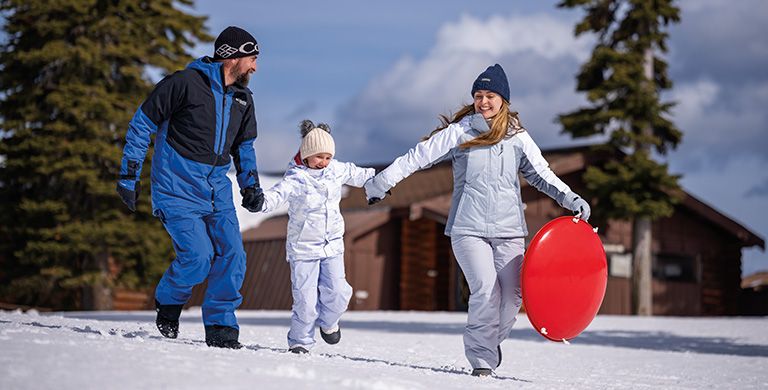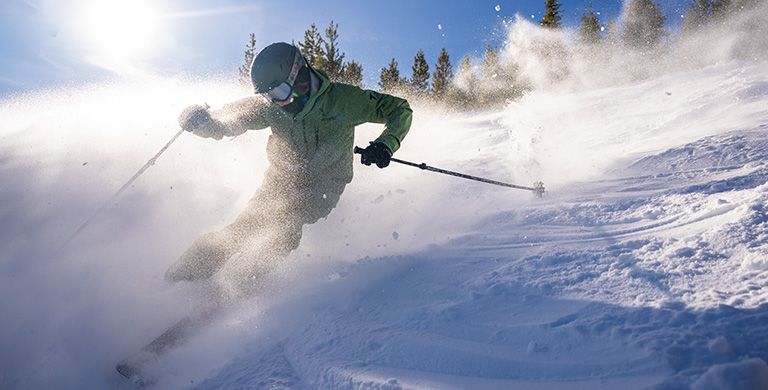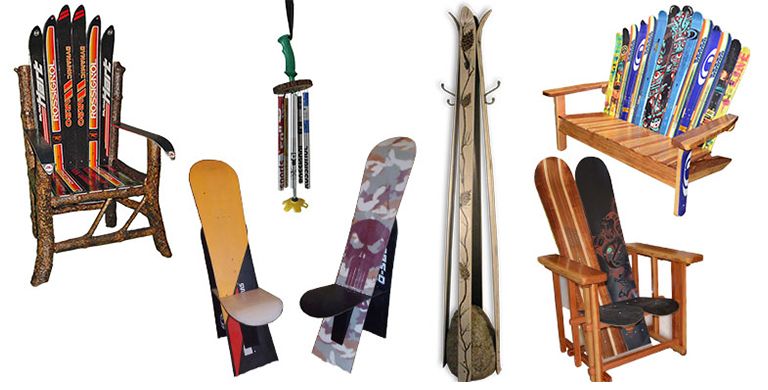SKI & SNOW
Ski Trip Essentials: The Ultimate Ski and Snowboard Trip Packing Guide
The fresh powder won’t wait for you to head back home and grab your gear. Here are some ways to ensure you pack everything you need for your next ski or snowboard adventure.
BY: NANCY BOUCHARD
Skiing is a gear-heavy sport, and assembling the perfect kit can sometimes feel as complicated as calculus. But a little planning goes a long way. Countless skiers and snowboarders have found themselves at the base of the mountain with one ski boot, no poles, a missing glove, or—gasp—no skis.
If you're hitting up a local resort, you might be able to dash home and grab what you forgot, but you'll be losing valuable time, fresh tracks, and probably some sanity along the way. And if you've flown or driven cross-country to chase those powder days? Well, you're either renting or scrambling to buy a replacement on the spot—neither of which screams "great start to a trip."
How do you avoid the dreaded gear goof? Simple: pack smart. A thorough, detailed packing list is your ticket to a stress-free ski and snowboard adventure. Whether you are skiing for a single day or a week-long trip, by following this guide, you’ll be ready to rock the slopes and make the most of every run.
If you're hitting up a local resort, you might be able to dash home and grab what you forgot, but you'll be losing valuable time, fresh tracks, and probably some sanity along the way. And if you've flown or driven cross-country to chase those powder days? Well, you're either renting or scrambling to buy a replacement on the spot—neither of which screams "great start to a trip."
How do you avoid the dreaded gear goof? Simple: pack smart. A thorough, detailed packing list is your ticket to a stress-free ski and snowboard adventure. Whether you are skiing for a single day or a week-long trip, by following this guide, you’ll be ready to rock the slopes and make the most of every run.

Pre-Season/Trip Preparations
Before heading out, make sure all your equipment is in good shape:
- Apparel: Check that your ski pants and jacket still fit properly. This is especially important for growing kids.
- Ski and Snowboard Boots: Make sure your boots fit. You want them to be snug, but with no hotspots. Too big boots can interfere with your ability to turn. If boots are too small, they will cause pain, and you might lose a toenail. If your child’s feet are still growing, consider renting boots for the season at your local ski shop.
- Bindings: Visually inspect bindings for loose screws. If a skier has gained or lost significant weight, the DIN setting should be checked.
- Helmet: Inspect your helmet for any cracks or signs of wear. Helmets last 3-5 years but should be replaced after a significant impact.
- Season Pass/Lift Tickets: You can save money by purchasing lift tickets, and season passes, in advance. Check with ski resorts, hotels and even airlines about deals.
- Ski tune up: Hopefully, you waxed your skis before storing them all summer. Before the ski season starts up, rewax them—making sure you scrape them--and consider tuning your edges or having a professional do it for you.
Packing Essentials
Each skier should have their own bag. A duffle bag
with at least 40 liters of capacity and backpack straps is ideal, as are dedicated ski bags designed to carry helmets, boots, goggles, and extra layers. This is where you’ll keep all your apparel and smaller equipment when you are not skiing.

Checklist
Pro-Tip: Print out a checklist for each skier and leave it in the ski bag. If you’re really on the ball, laminate the list with little boxes you can check with an erasable marker. Then, before you leave the house, hotel, or ski chalet for the slopes, check off each piece of essential equipment.
Apparel
- Hat: A beanie or ball cap is great for après ski festivities.
- Neck Gaiter: Never leave home without it.
- Sunglasses: You’ll want these when you are eating lunch outside on a bluebird day.
- Gloves: Bring an extra pair if skiing with kids. Mittens are often warmer than gloves.
- Hand and Foot Warmers: These are great for skiing with kids and helpful for anyone with cold hands. You can also stick them under the liner of a helmet or put them in your pocket.
- Ski Socks: Pick ones made of wool or synthetic materials. It never hurts to have a backup pair of socks in your ski bag. Just make sure they are long enough to cover your calves; you don’t want exposed skin between your pants and your boots!
- Baselayer Top & Pants: Again, select ones made of wool or synthetic materials. For a longer ski trip, pack two tops and one pair of pants.
- Mid Layer Top & Pants: You’ll want a midlayer for colder weather. This extra insulation can be in the form of a light down or synthetic jacket, a pair of thick synthetic pants, or even an extra baselayer to wear over your next-to-skin layer.
- Vest: Ideal for extra warmth without bulk.
- Shell or Insulated Jacket & Pants: These need to be waterproof and breathable. You want a set that is roomy enough to accommodate a layer or two underneath.
- Skis: If you are going to ski a lot, invest in a roof-top ski rack that encloses and protects your equipment. It’s a lot safer than putting your skis in the back of your car.
Gear
- Helmet: Check the buckle to make sure the adjustment is right.
- Goggles: Goggles come with a bag for good reason; it protects them from scratches when they are not in use. And you can use it to wipe snow, fog, and ice off your goggles during the ski day.
- Ski and Snowboard Boots: If you’ve removed the liners to dry them out, make sure you put them back in the boots.
- Poles: If you have growing kids, consider buying adjustable ski poles that can grow with them.
- Skins: If you are backcountry skiing, you’ll need these.
- Snow Safety Gear: You won’t need a shovel, beacon, or probe at most resorts, but if you’re skiing in dicey terrain or out-of-bounds, a snow safety kit is essential. If you are carrying an electric avalanche backpack, make sure it is charged. And always check your beacon’s battery life.
- Backpack: If you are skiing at a resort and taking lifts and gondolas, you may want a 10–20-liter pack for snacks, water, and extra layers. If you are going into the backcountry, you’ll need a larger pack with room for your snow safety equipment.
- Snacks: Essential for any ski day. If you bring your own food, you can have a more budget-friendly excursion. At the very least, pack a couple granola bars.
- Hydration: Bring a small, lightweight water bottle
- Sunscreen & Lip Balm
- Medical Kit: A small, lightweight medical kit is handy for any outdoor adventure. Slip a few band aids, gauze patches, and medical tape into a zip-lock plastic bag and keep it in your pack.
- Snow boots: Pick an insulated pair of winter boots with high-traction soles. You’ll wear these before you put on your ski boots, and for après ski activities.
Flying with Your Gear
Invest in a dedicated ski or snowboard bag large enough to hold your skis, poles, and snowboard. Get a bag that fits at least two pairs of skis or two snowboards so that you’ll have plenty of room. You don’t need a hardshell case but get a bag with wheels and padding.
- Pack Smart: Use your outerwear, base, and mid layers to cushion your skis. If you can only bring a single bag on your flight, pack your apparel in your ski or snowboard bag with your skis.
- Carry-On Essentials: Take your boots, helmet, gloves, and goggles on the plane with you as carry-on luggage. You can rent skis, poles or a snowboard if your luggage is lost or delayed, but there’s nothing like wearing your own boots.
- Safety: If you are traveling with an avalanche bag that uses compressed gas, make sure the cannister is empty.

Things To Remember When Planning a Trip
- International Student I.D.: Obtain one for discounts on lift tickets.
- Rescue Plans If you are traveling outside the US, consider purchasing an extra "rescue" plan with your lift ticket for added safety.
- Don’t forget your Travel Documents: If you are traveling out of the US, make sure you have your passport and any necessary visas. Check the expiration date on your passport; some countries demand that your passport be valid for at least six months after the date of travel.
- Don’t over pack: In most ski towns, you’ll not need anything fancy. Pack a couple of ski sweaters, underwear, a fun flannel shirt and everyday pants and you should be good to go. You’ll end up wearing your ski kit most days anyway.

Post-Ski Care
After a day on the slopes, proper gear maintenance is essential:
- Dry Out Your Gear: Bring your goggles, boots, and gloves indoors to dry overnight. Check your boot liners to make sure they aren’t damp. If they are wet, pull them out of the boot shells so they’ll dry more quickly.
- Ski Maintenance: Use an old towel to dry your skis before placing them in a rack.
- Conduct a visual inspection of your poles, boots, and skis after each day on the slopes.
For your next ski day, check out Columbia Sportswear’s line of ski jackets, ski pants & bibs, accessories and winter boots.



